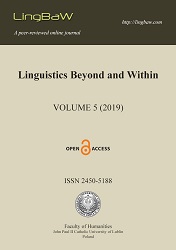Dephrasal adjectives in Polish – A case of syntax-inside-morphology
Dephrasal adjectives in Polish – A case of syntax-inside-morphology
Author(s): Joanna Kolbusz-BudaSubject(s): Morphology, Syntax, Lexis, Western Slavic Languages, Phraseology
Published by: Wydawnictwo KUL
Keywords: phrasal derivation; dephrasal adjectives; phrasal compounding; morphology-syntax interface;
Summary/Abstract: The present paper is part of a larger project which investigates the issue of “syntax-inside-morphology” in the domain of Polish word-formation. In what follows, we explore the thus far unstudied territory of dephrasal adjectives, such as tużpopołudniowy ‘right-after-noon’ and ponadstustronicowy ‘over-one-hundred-page’ built on phrasal bases subjected to suffixation. It is generally acknowledged that the Polish word-formation system is not designed to comprise phrasal compounding – a word-formation type which has come to be considered a flagship representative of the morphology-syntax interface (see Szymanek 2017 and Pafel 2017). Nevertheless, one may come across a number of Polish word-formation patterns, such as the class of nouns derived from PPs (e.g. nausznik ‘earmuff’ [[naP uszyN]PP -nik]N) or synthetic compound words (e.g. bydłobójnia ‘abattoir’ [[bydłN-o-bójV]VP -nia]N) which should clearly be considered legitimate members of the global “syntax-inside-morphology” community (see Kolbusz-Buda 2019a). In what follows, we want to argue that Polish dephrasal adjectives should be recognised as a case of morphology-syntax interplay on a par with the already attested cross-linguistic material. The phrasal character of the Polish data to be discussed in this study is so strong that researching this sui generis type of derivation seems not only a valid linguistic undertaking but also one with important implications. The study may have far-reaching consequences for the descriptive adequacy of the Polish word-formation system and point to new directions in the discussion on the morphology-syntax interface. The morphological structure of the adjectives to be discussed will be juxtaposed with the class of Polish compounds proper, in particular, synthetic compounds – a word-formation type which can be considered the closest in its morphological make-up to the presented material. Offering such a comparative perspective seems necessary as the adjectives to which we choose to refer as products of dephrasal suffixation are casually classified as compounds. Moreover, although Polish does not note any cases of phrasal compounding, the morphological structure of the adjectives in question will be additionally examined to discover potential parallels between the two word-formation types. The reason behind this undertaking is two-fold. Firstly, as has already been mentioned, dephrasal adjectives are classified as compounds; secondly, they contain a phrasal unit. In our analysis, we draw on a revised version of the Lexical Integrity Hypothesis, i.e. Lieber and Scalise’s 2007) Firewall Theory, which belongs to the current of the so-called mixed models of word-formation advanced in the recent years by, for instance, Ackema and Neeleman 2004 and Pafel 2017, allowing for a limited intermodular interaction between morphological and syntactic domains.
Journal: Linguistics Beyond and Within (LingBaW)
- Issue Year: 5/2019
- Issue No: 5
- Page Range: 75-89
- Page Count: 15
- Language: English

